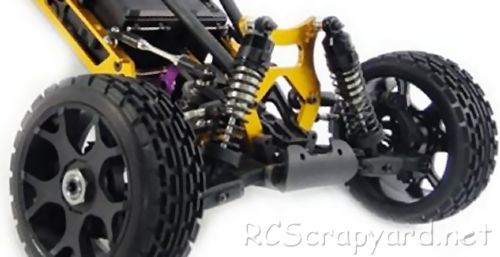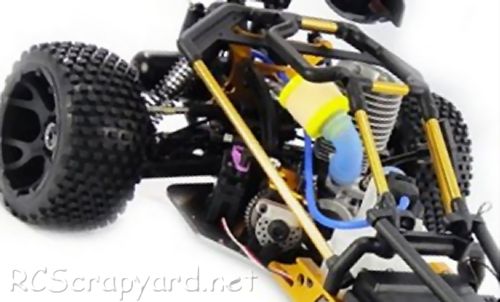

|
|
|


|
|
1/8 Scale Nitro Buggy:
CEN Dirt Striker - Radio Controlled ModelHistory and Info:
Introduced by CEN in 2012, the Dirt Striker 2WD Nitro Dune Buggy (# 10831 - SH21 Engine) - (# 10832 - SH28 Engine), was based on a 3mm CNC aluminum chassis, CVS (Constant Velocity Shafts), sealed 6 gear differential - silicone filled, coil spring over oil filled dampers, aluminum roll cage and 3 x carbon clutch shoes with CNC aluminum flywheel.
▼ Scroll Down for More Images ▼
|








|
|
|

★ CEN Striker Dune Buggy - Nitro Chassis ★

★ CEN Striker Dune Buggy - Nitro Chassis ★

|
Buying a Used CEN Dirt Striker Buggy (and What to look for)
Make a General Visual Inspection
Check the Body-Shell
If the body shell of your CEN Dirt Striker is broken, ripped or damaged in any way, this can be easily repaired with rubber solution glue. Also, for added protection and if available for your Dirt Striker model, fit an under guard to stop dirt and gravel entering the chassis. Drive Shafts and Turnbuckles
Examine the Drive System
The gearbox of your used Buggy should be opened up to check for gear wear and lubrication. A thin coat of grease is often used on internal gears and although this is fine for basic running around on the back yard, if you intend to race your Buggy at a higher level, this should be removed and replaced with racing oil (ZX1 or Teflon Oil). Of course, this should be reapplied after each race meeting. Pinions and Spur Gears
Don't Neglect the Ball-Joints
Ball joints always cause problems. For top level Nitro Buggy racing, the plastic ball connectors should be checked and if deemed necessary changed after every meeting. A simple thing like a loose fitting connector popping off could easily end your race, so better safe than sorry. Steering Servo and Servo-Saver
Stabilizers
If body roll on your CEN Dirt Striker is a problem, handling can be improved with the use of stabilizers, anti roll or sway bars, stiffer tuning springs and, or, thicker silicone oil in the dampers. Don't Forget those Bearings
▼ Scroll Down for More Articles and Advice ▼
Or, check out our RC Model Car Setup Guide
|
|
Manufacturers and Brands Catalogued, Listed and Reviewed by RC-Scrapyard.
At present, the RC Model Manufacturers, Brands and Distributors covered by us are: ABC Hobby, Academy, Acme Racing, Agama Racing, Amewi, Ansmann Racing, ARRMA, Team Associated, Atomic RC, Axial, AYK, Bolink, BSD Racing, Capricorn, Carisma, Carson, Caster Racing, Cen, Corally, Custom Works, Durango, Duratrax, ECX - Electrix, Exceed RC, FG Modellsport, FS-Racing, FTX, Fujimi, Gmade, GS-Racing, Harm, HBX, Helion, Heng Long, Himoto Racing, Hirobo, Hitari, Hobao, Hong-Nor, Hot Bodies, HPI, HSP, Intech, Integy, Jamara, JQ Products, Kawada, Kyosho, Losi, LRP, Maisto, Mardave, Marui, Maverick, MCD Racing, Megatech, Mugen, New Bright, Nichimo, Nikko, Nkok, Ofna, Pro-Pulse, Protech, PTI, RC4WD, Redcat Racing, RJ-Speed, Robitronic, Schumacher, Seben, Serpent, Smartech, Sportwerks, Step-Up, Tamiya, Team-C Racing, Team Magic, Thunder Tiger, Tomy, Top Racing, Traxxas, Trinity, Tyco, Vaterra RC, Venom, VRX Racing, WLToys, X-Factory, Xmods, Xpress, Xray, XTM, Yankee RC, Yokomo, ZD Racing and Zipzaps. |
|
Hints, Tips and Information
Choosing the right Tire Inserts
Once upon a time, all RC model tires were equal - they were all trash. None of the old tires had any kind of internal support, because the hard compound they were made of didn't need it. But that was before the newer soft compounds were developed. These new tires were so soft that if some kind of insert was not used they would just lay flat under the weight of the car. Thus, the new science of tire inserts was born. Inserts for Off-Road Tires
The basic soft foam inserts that come with many off-road rubber tires can be in one of two types. They can be basic rings of sponge, or the cheap and nasty strips of sponge. Many of the latest foam inserts now come pre-shaped, but more than often, they will need some work done to them before they are inserted into the tires. |
|
Hints, Tips and Information
Look after your Gears
In RC there are a number of different gear teeth sizes we tend to use, based on two systems. Imperial and metric. |
|
RC Models:
|
Radio & Motors: |
Other
Accessories: |